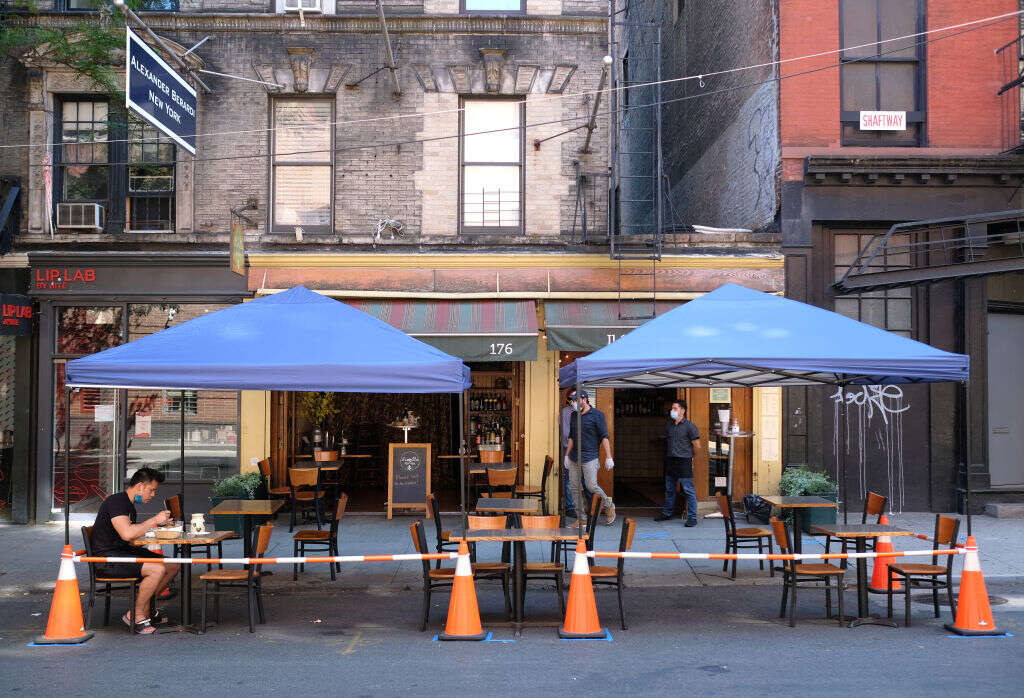
Most people don’t spend much time thinking about curbs, but these quotidian barriers between street and sidewalk gained new importance for urban planners during the pandemic.
As every inch of outdoor space became coveted ground in dense US cities, the unprecedented circumstances provoked a lot of experimentation in the ways curb space is used.
“Even in what are truly tragic situations, like what we faced over the last year, it did force people to question assumptions and try new things,” says Beth Osborne, director of Transportation for America. “As long as we have to go through something as terrible as Covid, we might as well learn from it.”

A new report from Osborne’s organisation highlights lessons from myriad municipalities, large and small, that tried opening up curb and road areas and playing with what is, after all, a public space that is usually dominated by cars.
The study, “Covid and the Curb,” covers large metropolises like San Francisco and Boston, as well as smaller cities like Ann Arbor, Michigan.
Cutting through the red tape
To help local restaurants, Ann Arbor waived fees for sidewalk occupancy permits and converted street parking into 15-minute pickup zones outside restaurants. Street closures were pursued in some areas to allow for more outdoor dining, while the city footed the $50,000 bill for street barriers. There was also the Healthy Streets Initiative, which closed down roadways to allow for more exercise and play in spaces otherwise overrun by fast-moving automobiles.
Transportation for America doesn’t gloss over the fact that these changes can also attract blowback. Ann Arbor residents complained about road closures causing traffic. City staff criticised themselves for implementation taking too long, which generated more backlash than might have otherwise occurred. Cones and other barriers were less effective than the city hoped because residents frequently moved them of their own volition.
“I don’t think it’s any news to local municipalities that anything you do that’s new will contain a bit of scepticism,” says Robert Kellar, Ann Arbor’s communications specialist for public services. “But I think these are the type of times where people are going to be a little bit more open to new ideas with everything that was happening.”
Transportation for America’s report includes an array of policy recommendations, which range from reforming or eliminating parking minimums to giving localities more control over state highways, allowing more latitude within their boundaries.
Some recommendations could be more easily achievable in the short term because they are up to the discretion of the cities themselves. More automated enforcement of curb rules, for example, could save resources and reduce the amount that law enforcement and security staff interact with residents. Or the process of securing outdoor dining or food truck placement could be sped up by lowering barriers to entry for smaller businesses and other entities that may not be familiar with the ins and outs of city government.
In a lot of cases, we will decide we like it this way, and wonder why we didn’t always do it like this. Mae Hanzlik, Transportation for America
In Boston, for example, outdoor dining was much more difficult to create before the pandemic: it required presenting surveys and engineering designs to be reviewed by the Public Improvement Commission. Permitting was required from multiple departments, as were fees and a public hearing. All this was either waived or reduced during the pandemic.
Similarly, any changes to a curb had to be reviewed by several divisions of the Boston Transportation Department, a process that could take months. During Covid, much of this was simply left to the agency’s planning division, which greatly hastened the process. Similarly, in Washington, DC a process was set up to allow outdoor dining permits to be approved within 72 hours.
A new outlook
Mae Hanzlik, the study’s lead author, says she hopes the pandemic experience will encourage localities to be more flexible.
“We’re not going back to normal, because, in a lot of cases, we will decide we like it this way, and wonder why we didn’t always do it like this,” says Hanzlik, programme manager for Smart Growth America. “But in many places, as things get back to normal, different pressures will rise. So we know that all these changes won’t be permanent.”
In Ann Arbor, many of the modifications will be rolled out again in the spring as the cold weather eases. The Healthy Streets Initiative will be utilised again and expanded. This time, the city will reach out to communities that were perhaps not heard from in earlier policy conversations, to ensure the street closures are not inconveniencing workers who use public transit. (Ensuring equity of access is a policy highlighted in the study, which notes that Oakland, California tried to prioritise feedback from lower-income and non-white communities after realising that many of those weighing in on curb policy came from select social groups.
In general, Ann Arbor policymakers anticipate their open-streets and curbs policies will be even better received in 2021 than in 2020.
“Ann Arbor is a very progressive place, but it is still very car-centric,” Kellar says. “But once people got the taste of what this was going to be like, that it wasn’t going to be the nightmare scenario they had envisioned, attitudes changed in favour of it.”






